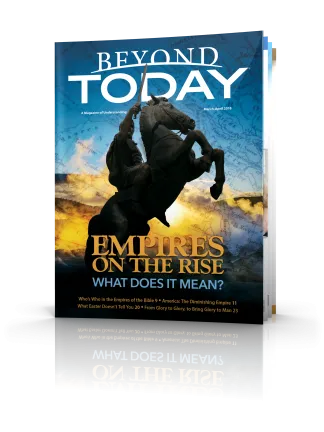Who’s Who in the Empires of the Bible

The Bible mentions a number of kingdoms and empires. This overview will help you understand which played what roles in the history of the Bible—and in roles yet to come!
The Bible recounts the rise and fall of mighty kingdoms and vast empires, primarily through the lens of their relationship to biblical Israel and Judah. The story follows Israel’s oppression, rise to prominence, destruction and subjugation. Ultimately, Bible prophecy tracks the progression of world empires even to modern times and beyond—to the Kingdom of God at the second coming of Jesus Christ.
Egypt
Egypt is one of the oldest empires recorded in history. It enslaved the people of Israel for more than two centuries before they became a nation.
God delivered the Israelites from slavery at the time of Moses through devastating plagues. This crippled Egypt, yet it would remain a key player in the region, its power waxing and waning. In its stronger periods it still exercised influence to the north, at times cooperating with and at times hostile to the kingdoms of Israel and Judah. Its power and wealth often brought it into conflict with other kingdoms and empires of the region.
Israel and Judah
After the family of Israel moved to Egypt, it soon grew into a nation of two to three million people. Being delivered from bondage in Egypt, God gave them the land of Canaan according to His promise to Abraham (Genesis 12:7). It would take another 400 years after the Exodus before Israel would become a monarchy and major power in that part of the world.
Under the reign of King David and his son and successor, Solomon, the nation ascended to the apex of its power and influence. The land of Israel is situated ideally at the meeting point of three continents—Europe, Africa and Asia. Under Solomon’s rule, this positioning along the world’s most important trade routes made the country exceedingly rich.
The rise of Israel to this high position was the result of God’s covenant blessing, but her prominence and wealth declined sharply after Solomon’s reign because of disobedience to God’s law. At Solomon’s death the kingdom split into two, with the northern 10 tribes retaining the name “house of Israel” and the southern tribes of Judah and Benjamin with a large part of Levi under the name “house of Judah.”
The kingdom of Israel quickly abandoned the worship of God, while the kingdom of Judah vacillated for decades at the whims of her kings. The two would war with each other as much as with the surrounding nations and eventually be punished by God by being invaded and exiled from their land by the empires of Assyria and Babylon.
Assyria
The Assyrian Empire, situated northeast of the land of Israel in what is largely modern-day Iraq, served as “the rod of [God’s] anger” (Isaiah 10:5) against the kingdom of Israel. Assyria’s destruction and deportation of Israel came at the height of its reign as world superpower. By all historical accounts, the Assyrians were vicious and merciless conquerors.
Later the Assyrians invaded Judah, carrying many of its people away captive and putting Jerusalem under siege, though God devastated the Assyrian forces and delivered Jerusalem. Assyria went on to conquer Egypt, setting the trend for future empires invading from the north.
With Israel and Judah being diminished in power after Solomon’s death, their lands were repeatedly invaded from both north and south as other powers followed the major trade and travel routes through Israel.
The Bible plainly states that God was the source of Assyria’s meteoric rise in power to fulfill the purpose of punishing Israel. Yet God would also bring judgment on the Assyrians, their subjects rising up against them—particularly the Chaldeans of Babylon.
Babylon
Situated southeast of Assyria, Babylon emerged as the next instrument of God’s punishment—against both Assyria and the kingdom of Judah.
After the Assyrian invasion was thwarted, Judah continued as a kingdom for more than a century with only intermittent worship of God. In the end, Judah’s disobedience brought defeat and exile at the hands of Nebuchadnezzar, king of Babylon, in about 587 B.C.
God used the prophet Daniel, one of the captives of Judah taken to Babylon, to unveil a roadmap for the next several thousand years of Bible prophecy regarding gentile kingdoms.
Daniel 2 and 7 prophesy, in remarkable detail and accuracy, the fall of Babylon to Persia, the fall of Persia to Greece, the fall of Greece to Rome, numerous revivals of the Roman Empire, and their eventual demise at the coming of the final superpower—the Kingdom of God, to be established on earth at Jesus Christ’s return.
Major elements of Babylonian religion and culture continued on in various respects through each of these kingdoms. Thus, the last end-time human superpower is also referred to as Babylon (Revelation 17:3-6). Sadly, many of ancient Babylon’s false religious practices still permeate Christianity today.
Babylon, like Assyria before it, was defeated and destroyed because of its pride against God. In a show of God’s judgment, the Medo-Persian Empire conquered Babylon in a single night (Daniel 5:30-31).
Persia
The Persian Empire, centered in what is today Iran, was distinctively tolerant of the religions of its subjects. Babylon was an instrument of punishment against God’s people, but Persia’s purpose was to provide relief and allow for a degree of restoration of Jewish worship. The exiles of Judah, forcibly removed to Babylon, were permitted by special decrees from three different Persian kings to return to Jerusalem and rebuild their temple.
God was looking far ahead in His use of the Persian Empire. To fulfill messianic prophecies through Jesus Christ, the people of Judah needed to be resettled in the land of Israel. The Persian Empire repositioned Judah for the coming of the Messiah, but the Greek and Roman empires paved the way for the spread of the gospel of Jesus Christ in other critical ways.
Greece
The Macedonian king Alexander the Great took over the rule of Greece and stormed through the world with unheard of speed and efficiency, overthrowing and engulfing Persia in a span of only 10 years. While Babylon and Persia sought political control and wealth, neither imposed cultural domination as Alexander’s Hellenistic Empire did.
Greek became the common language of the known world, and continued as such well into the Roman period. The universality of Greek allowed for the rapid spread of the gospel both in spoken and written word. The New Testament was written and preserved in Greek.
When Alexander died, his empire was eventually split into four parts, with two of these most prominent. The Seleucid Dynasty ruled over Greater Syria, including the lands of Assyria, Babylon and Persia. And the Ptolemaic Dynasty—the Greek pharaohs—ruled over Egypt. These alternately dominated the resettled Jews in the Holy Land.
Syrian Greek rule would become characterized by cruelty and flagrant disrespect for the religious practices of the Jews at the temple, particularly under Antiochus Epiphanes, leading to a Jewish revolt around 167 B.C. Jewish independence would be short-lived and far from the glorious vision promised in prophecy. Greek grasp on the rest of the empire continued to gradually slip until the Romans rose to power, conquering Jerusalem in 63 B.C.
Rome
Rome was the fourth and final beast of Daniel’s visions, which was “different from the others” (Daniel 7:7). True to the terrifying images Daniel saw, the Roman Empire dominated militarily unlike any empire before it. In addition to their unique organizational and strategic warfare, the Romans also attracted soldiers from every conquered with the possibility of Roman citizenship, which carried substantial social and economic privileges.
Rome’s military supremacy helped with the spread of the gospel in two vital ways. The efficiency of its armies depended on an extensive system of roads, allowing them to travel quickly throughout the empire in response to threats—but also allowed safe and easy travel for the apostles’ preaching efforts. Secondly, the regional peace and stability enjoyed throughout the Roman world, known as the Pax Romana (“Peace of Rome”), made for a receptive environment for the early Church to grow.
The Roman Empire did not end with the fall of Rome in the West in A.D. 476, and neither did it end with the fall of the eastern capital of Constantinople nearly 1,000 years later—or with the end of the Holy Roman Empire a few centuries after that. According to Daniel, the Roman Empire would undergo 10 resurrections, the last seven of them in concert with a false religious power, right up until the time of Jesus Christ’s second coming —in other words, up through our day!
Most recently was Hitler’s Germany. Note that the German honorific title “Kaiser” comes directly from the Roman “Caesar.” At Beyond Today magazine, we recognize the current efforts to create a unified European superstate as significant steps in the process of forming the prophesied final revival of the Roman Empire. This underpins and informs our analysis of unfolding events in Europe.
The final superpower
The vision explained in Daniel 2 ends with a stone striking the statue representing the succession of four great gentile empires starting in Daniel’s day and continuing to the end time. The stone strikes the feet and toes of this image, its final stage, with Daniel revealing: “In the days of these kings the God of heaven will set up a kingdom which shall never be destroyed; and the kingdom shall not be left to other people; it shall break in pieces and consume all these kingdoms, and it shall stand forever” (Daniel 2:44).
The grand climax of Daniel’s prophecy is the establishment of the Kingdom of God—the true final world superpower that will endure forever. The Rock that struck the statue is none other than Jesus Christ! As we see nations continue to war and conquer, we should remember Christ’s own words in Mark 1:15: “The Kingdom of God is at hand. Repent, and believe in the gospel.”






